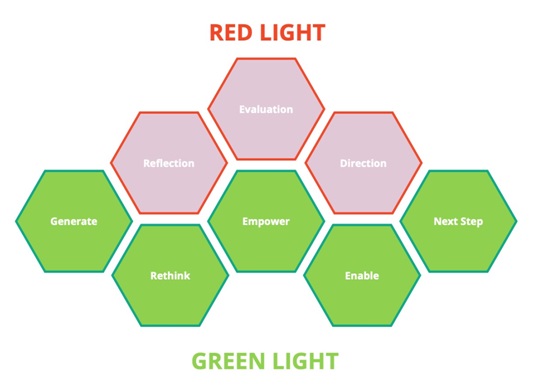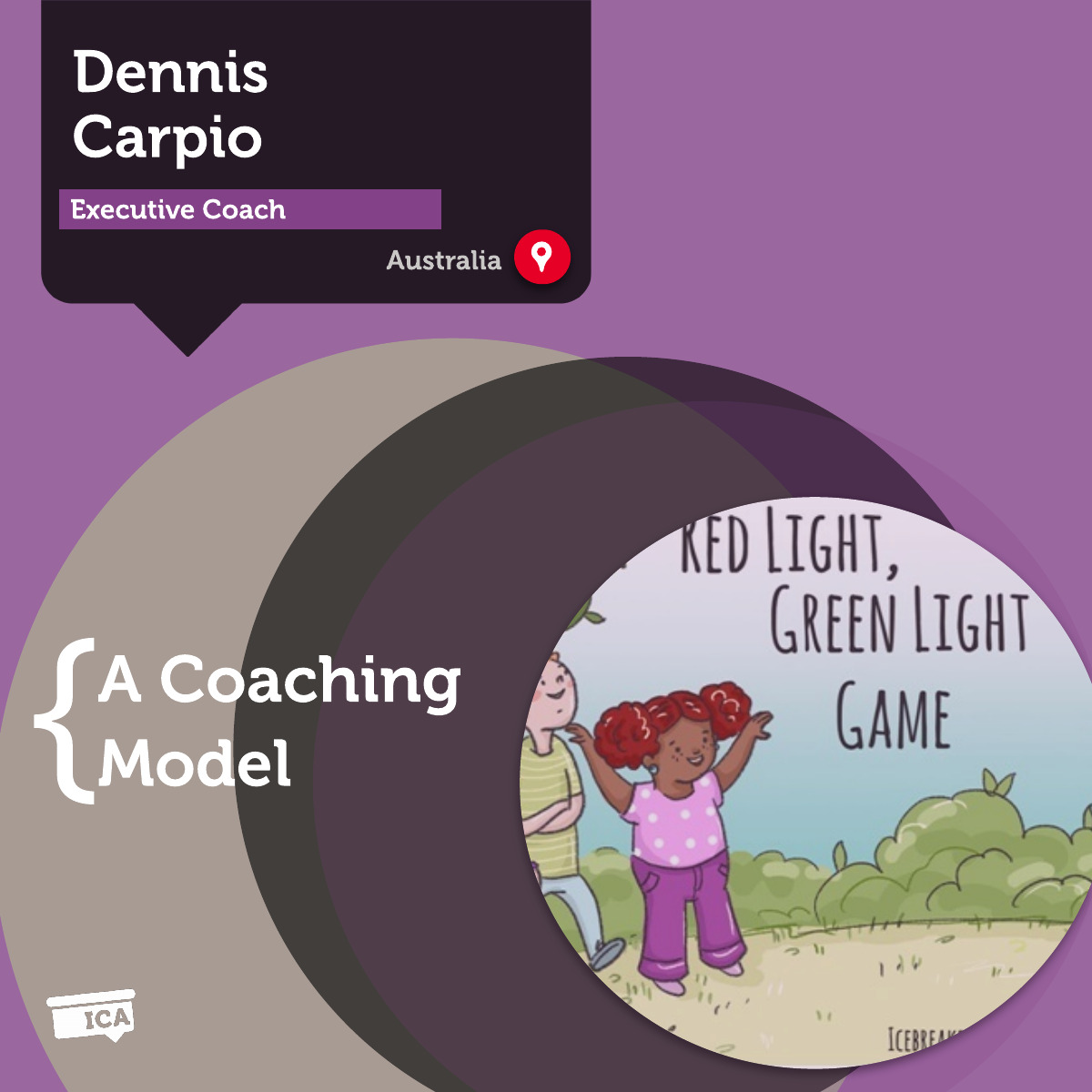A Coaching Model By Dennis Carpio, Executive Coach, AUSTRALIA
The Children’s Game “Red Light, Green Light”
 Help your client move forward from their challenges or problems using the Red Light, Green Light coaching model. The 2-part framework will help your clients gain clarity of their situation or problem (the Red Light) and gain new learning about themselves and their situation so that they can move forward (the Green Light). The model is inspired by the children’s game from South Korea, “Red Light, Green Light”, which exploded in popularity in 2021 thanks to Netflix’s smash hit show “Squid Game” (Dong-hyuk, 2021). This model will not include any of the show’s violence but takes inspiration from the show’s first episode “Red Light, Green Light”. The episode featured a deadly iteration of the popular South Korean children’s game, where anyone caught moving is shot dead on the spot once caught by a creepy-looking giant robotic doll(Wikipedia, 2011).
Help your client move forward from their challenges or problems using the Red Light, Green Light coaching model. The 2-part framework will help your clients gain clarity of their situation or problem (the Red Light) and gain new learning about themselves and their situation so that they can move forward (the Green Light). The model is inspired by the children’s game from South Korea, “Red Light, Green Light”, which exploded in popularity in 2021 thanks to Netflix’s smash hit show “Squid Game” (Dong-hyuk, 2021). This model will not include any of the show’s violence but takes inspiration from the show’s first episode “Red Light, Green Light”. The episode featured a deadly iteration of the popular South Korean children’s game, where anyone caught moving is shot dead on the spot once caught by a creepy-looking giant robotic doll(Wikipedia, 2011).
Using analogies in coaching can be powerful especially when your client can immediately relate to the metaphor. The Red-Amber-Green (RAG) traffic light system is universally recognizable except for Bhutan, the only country in the world that does not have them(Tourism Council of Bhutan, 2021). You may need to use a different framework if your client is from Bhutan.

The Red Light, Green Light Model
The Red Light, Green Light model uses the traffic light signaling system where red light means stop, and green means go or move. It is a metaphor that reflects the journey a coaching client goes through in the coaching process. Typically, at the start of a coaching session, the client feels encumbered by some difficult circumstance or dilemma that causes them to“freeze” or feel paralyzed, unwilling, or unable to decide and move forward. At this stage, we say the client is at a “red light”, causing them to “stop,”; forming a solid belief that they cannot proceed. Through coaching, the coach helps the client gain clarity of their situation, what they truly desire, and become aware of any blind spots.
At this moment of breakthrough, the client can now see possibilities and generate new empowering thoughts that could help them move forward, plan the next steps and set themselves up for success. We will call this part of the coaching process the Green Light phase, where the client feels liberated from their limiting beliefs and can now see the open road ahead of them.
The model uses the acronyms R.E.D. and G.R.E.E.N. as a framework for coaching. I recommend the model to help your clients understand their mental blockers and blind spots and discover new ideas to help them move forward. The model applies across all areas of life, either professional or personal life challenges, or both.
R.E.D.is an acronym for
- Reflection– the client gains awareness of their reaction to their current situation
- Evaluation– the client evaluates what is essential to them and what they want to achieve by way of outcomes
- Direction – the client defines what they need to address to achieve the outcomes that they want to accomplish
G.R.E.E.N.stands for
- Generate – the client gains newfound awareness of their situation and identifies possible options that could help them achieve the outcomes that they want to accomplish
- Rethink–the client gains new learning about themselves and their situation and considers how they will use the new understanding to move forward
- Empower – the client chooses an empowering action plan that will help them move forward
- Enable–the client sets themselves for success by considering what could help improve their chances of success
- Next steps – the client commits to post-session thinking, reflection, or actions
While in an acronym form, the Red Light, Green Light model is not a linear coaching process, as the coaching conversation remains, as it should be, client-led.
This coaching model adopts principles and practices from Reflective Inquiry, such as mirroring, or what Marcia Reynolds calls active replay in her book entitled Coach the Person, Not the Problem: A Guide to Using Reflective Inquiry. Inactive replay, the coach summarizes, paraphrases acknowledges key phrases and shares the emotions and gestures clients express (Reynolds, 2020).
When the clients hear their words or are made aware of their emotions and gestures, clients start to become aware of how their beliefs form their perceptions and could then better face their emotions.
RED LIGHT
Reflection
In Reflection, the intent is to help your client gain a better understanding of their current situation, their goals or challenges, and how it is affecting their state of mind, emotions, and actions.
Coaching Questions:
- It seems like you are deep in thought. What is coming up for you now?
- You said (insert client’s words), how do you feel about this?
- You said you’re sure (topic) is impossible. What makes you believe this is true?
- You said you felt (client’s emotion). What is causing you to feel that way?
- You paused when you mentioned (the client’s subject/topic). What thoughts came up?
Evaluation
Go deeper into your client’s belief system by using your client’s current state of mind, gestures, words, and behavioral patterns to understand their values and what is meaningful to them. Help your client gain a better understanding of their reaction to the situation by evaluating these insights and help them discover the outcome that they truly want to achieve.
Coaching Questions:
- You mentioned (client’s words) several times. What does this mean to you?
- What are some possible implications of this situation?
- What else could this (client situation) mean?
- What would an ideal outcome look like?
- How do you know you have achieved that outcome?
- How would achieving/not achieving that make you feel?
Direction
Your client may have given you a range of things to deal with. Establish a direction by guiding your client towards a specific area to focus on.
Coaching Questions:
- What feels most useful to address in this situation?
- How important is this to your ideal outcome?
- What would a successful change look like?
- What is getting in the way?
- What would not change mean to you?
GREEN LIGHT
Generate options
Upon successfully defining your client’s desired outcome and focus area, you may now help them begin creating that path forward. Start by having your client use their creativity to come up with options, as many as they can think of, that could help them achieve their desired outcome. We are looking for possibilities, so encourage your client, not to self-reject ideas at this stage.
Coaching Questions:
- If there are no limits, what else could be possible?
- What could help you get closer to your ideal outcome?
- What have you been thinking of trying but haven’t?
- If the opposite is true, what else could you try?
- What could you do differently next time?
- If given by your client: what would your (hero, future self, ideal version) do?
Rethink
Brainstorming options not only gives your client possible solutions to their problem, but it could also sometimes help them discover an insight about themselves or their situation. Use this newfound awareness to help them decide what actions to take.
Coaching Questions:
- From these options, what feels like the right target?
- What option is the most impactful and easiest to start?
- What option makes you feel most uncomfortable?
- What about it makes you feel uncomfortable?
- What if the opposite is true?
Envision
Several studies have claimed that visualizing achieving one’s goals helps in optimizing chances of success (Pillay, 2014). If your client is comfortable with it, invite your client to imagine going through their action plan, visualizing themselves going through the journey towards achieving their goals. Use these questions to guide your client.
Coaching Questions:
- What would go through this look like? Feel like?
- How do you see this going well?
- What could smaller wins look like?
- How could you reward yourself for small wins?
- How committed are you to achieving this?
Enable
At this stage in the coaching session, your client might be feeling energized and seemed to have gained significant willpower to spring into action with their new learning and ideas; however, willpower alone is not enough to sustain your client’s progress. Unfortunately, research shows that willpower, or the ability to control oneself and the decisions one makes, fades over time. In his book, Atomic Habits: An Easy & Proven Way to Build Good Habits & Break Bad Ones, James Clear suggests making the action easier to do either by scaling it down into smaller steps and/or leveraging existing habits, systems, and environment can help boost and sustain willpower(Clear, 2018). Use the following to guide your client in this thinking.
Coaching Questions:
- What could help make this option much easier to do?
- What available support, resources, or tools could help?
- In case you hit some setbacks, what could help you get back on track?
- How else could you increase the likelihood of success?
- What could help remind you of your commitment?
Next Step
Finally, it is time to get your client to start moving forward. James Clear also highlighted the importance of momentum and getting started (Clear, 2018). It can be very tempting for people to delay and procrastinate.
Coaching Questions:
- What is your immediate next step forward?
- What can you start doing tomorrow?
- What is your timeframe for getting this done?
- What key learnings will you take away from this session?
- How might you apply what you’ve learned today in the future?
Learn How to Create Your Own Coaching Model
Your Coaching Model reflects your values,
philosophies and beliefs and must communicate who you will coach
and the problems you will solve. Read more about creating your coaching model
References
Icebreakerideas.com (banner image)
Clear, J. (2018). Atomic Habits. New York: Penguin Random House.
Dong-hyuk, H. (Director). (2021). Squid Game [Motion Picture].
Pillay, S. (2014, March 05). To Reach Your Goals, Make a Mental Movie. Retrieved from Harvard Business Review
Reynolds, M. (2020). Coach the Person, Not the Problem: A Guide to Using Reflective Inquiry. Berrett-Koehler; Illustrated edition.
Tourism Council of Bhutan. (2021, November 28). The only country in the World with no Traffic Lights. Retrieved from Bhutan – Happiness Is A Place
Wikipedia. (2011, November 28). Squid Game.
